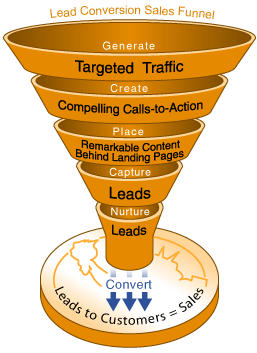Not enough blog readers buying your products? Join the club.
If you could only work out where you are losing leads then you could fix them.
If you are a blogger who wants to earn more, then converting more readers into buyers is what you want to do. This article will show you how to analyze your conversion process, how to improve the process, and how to stop lost leads.
What are the Stages in Your Conversion Funnel?
Funnels are no longer as simple as they used to be. Marketing is no longer a linear process and each customer’s journey through your conversion process will be unique. Unique Influences from social media conversations, to checking your reputation online and the different devices they use.
It is tempting to shy away from trying to make exact measurements, but even with fuzzy funnels measuring is still necessary, because without measurements there is no way to know whether your conversion process is improving.
Fuzzy Funnels
Conversion funnels were never the continuous, smooth slopes that the word suggests. There were always definite steps in the conversion process. Those steps from one level to the next are still there and that is what you can measure. The levels are fuzzy but the steps are as definite as they always were.
Individuals will spend different amounts of time on each level and the levels themselves are not as definite or smooth as marketing books would have us believe.
Traditionally a blogger’s conversion funnel might read like:
- First-time blog visitors
- Blog readers
- Repeat visitors
- Subscribers
- Free product
- Low-cost product
- High-cost product
Nowadays people will be influenced by others factors, especially by social media interactions, shares and recommendations. Each lead can also be a source of more leads if they are happy and you are doing things right.
Measuring Conversions
It would be over-simplistic just to measure blog readers and high-cost product sales. You really need to measure how many leads take each step. In a 7 level funnel there are 6 steps and each can be measured.
First-Time Blog Visitors – Blog Readers
You need to entice visitors to become readers. This metric is measured by your bounce rate. If you attract 100 visitors and 90 click away because they found your content to be boring then you are in trouble with a 90% bounce rate.
Improving Bounce Rate
KISS – Your home page must load quickly and Simple Website Design. Its purpose is to showcase your inner pages in an enticing way. Avoid putting full blog posts on there. Use super headlines and the killer first paragraph of each post.
Your headline’s job is to make people read the first paragraph and the first paragraph’s job is to make people read the entire post. Treat it like a newspaper article and get the essential points in those first few lines. Hook the reader and keep him hooked.
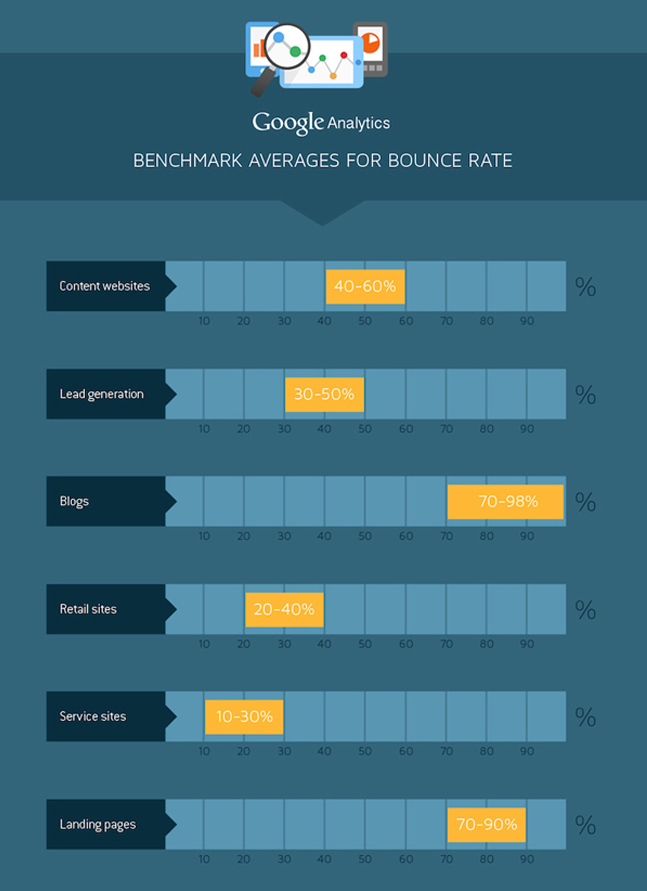
Be realistic in your target-setting. You can use the Hubspot infographic above as a guide.
Blog Readers – Repeat Visitors
StatCounter or Google Analytics will give you this information at a glance.
Improving First-Time to Repeat Visitor Ratio
If your content is outstanding and available nowhere else, then more site visitors will bookmark your site and return. Automated curated content? Forget it; All it will get you is one-off visitors who will click away immediately.
Hard work and outstanding content are the answer.
Repeat Visitors – Subscribers
Blog readers might jump 2 steps and be so impressed with your subscription offer that they sign up at their first visit.
Getting More Subscribers
1. Stop using the word “Subscribe”
In his CopyBlogger post “How to Increase Your Blog Subscription Rate by 254%“, Willy Franzen describes how he changed the wording on his sign up link from “Subscribe” to “Get Jobs by Email”. His sign-up rate more than doubled.

2. Blog More Often
A A Hubspot subscriber survey found that businesses that blogged regularly (More than once a week) increased their subscription rate by 50% over those who only blogged once a week.
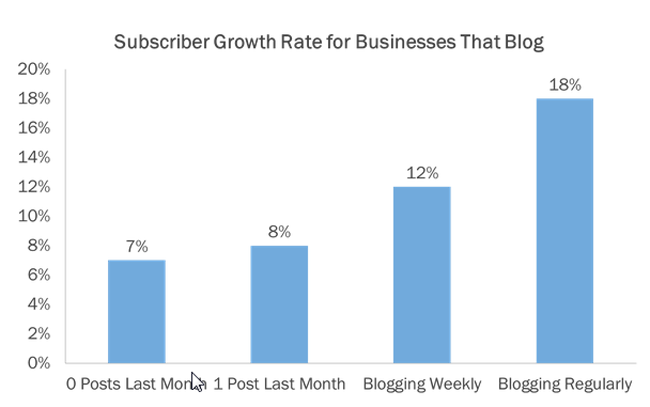
3. Use a Pop Up
Pop-ups are something we have all learned to live with, nobody likes them, but they work.
Dan Zarella compared his subscription rate and bounce rates both with and without pop-up forms. His subscription rate with the form was twice as high for only a marginal increase in bounce rate.
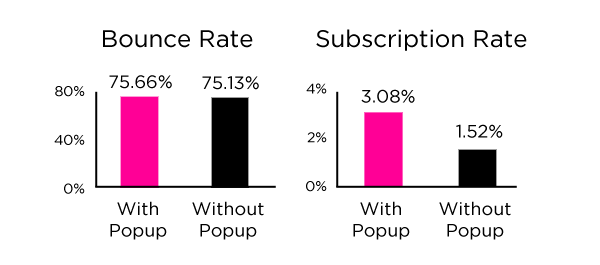
4. Use an Exit Overlay
Exit overlays show when the software detects that the user is about to leave your site. It is your “last chance” to get an email address from a visitor, and it works.
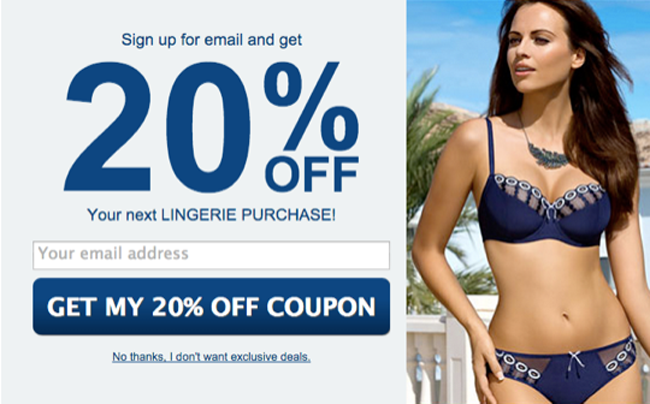
A study by GetResponse quotes Laninia Lingerie as boosting their email subscription rate by 2.6% when they used an exit overlay with an immediate 20% Off Next Order incentive. Laninia Lingerie could afford to offer the incentive because of the long-term value of each person who signed up as an email subscriber.
Subscribers – Free Product
Many bloggers omit the “Free Product” level on their funnel, but it is important and helps build trust.
Giving Away More Freebies
Once you have permission to send emails then you need to survey and segment your subscribers to make sure you only send relevant emails to each group. Make the freebies relevant and useful to each segment. Hubspot have a different freebie on each group of pages on their site. They use them as email subscriber incentives, but the principle of relevance holds, regardless.
Free Product – Low-Cost Product
This is the biggie – This is the first time your subscriber has trusted you with their cash. You need to get it right.
Selling More Low Cost Products
Reduce the perceived risk to zero. Make the price you charge for the first paid product as low as $1 to $5. You have to ease subscribers over the psychological barrier that they have to pay you. Once they are over the first barrier they will be more willing to pay more for a higher value product in the future.
Everything you sell must offer much higher value than subscribers could ever reasonably expect.
Low-Cost Product to High-Cost Product
In reality you will have a series of products that gradually increase in value.
Selling More High-Cost Products
As you earn subscribers’ trust they will be more willing to risk larger amounts of money. Make sure your products are high-value as well as higher-priced. The perceived value should be astronomical to help convince people to buy. “Bonuses” are one way to “add value” and have become expected, but the value of your core product should far and away exceed any bonus products.
If it solves buyers’ pain points well-enough then they will buy. Include user reviews, with photos of the user and links to their website or social profile to increase authenticity.
Where Do You Start?
There are several different approaches you can take once you have the conversion data for each step in your funnel.
The overall conversion figure is found by multiplying all the separate conversion figures together. The tables below are taken from a GetResponse blog post on plugging leaky funnels.
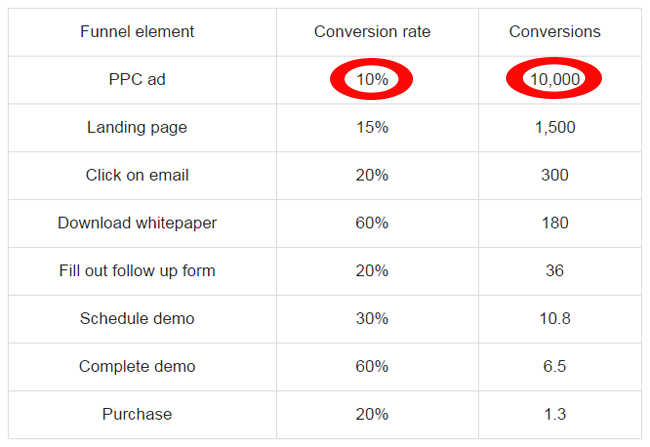
In the table above the overall conversion rate is: 10% x 15% x 20% x 60% x 20% x 30% x 60% x 20% = 0.001296%
If you increase any of the conversion figures by a 50% then the overall conversion figure also increases by 50%.
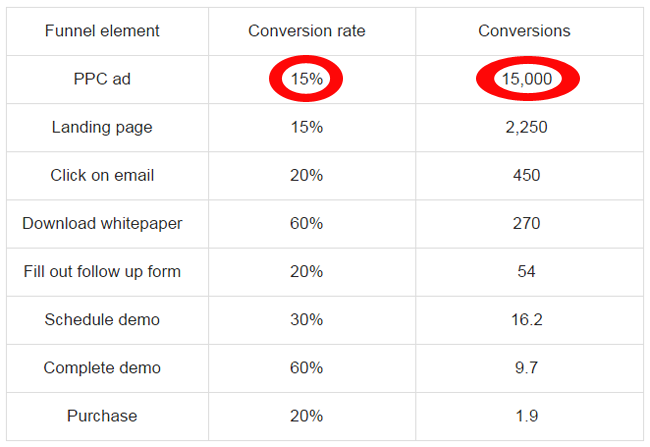
Logic would say to choose the step that is easiest to improve conversion on first. And work up to the hardest step to improve, just working on one step at a time.
You do need to be careful that improving one step does not reduce the conversion figures for other steps. If your final product is “How the Larger Woman Can Design Her Own Bikini from old Socks” and your original PPC ad targets larger women, then changing the PPC ad’s emphasis to medium-sized women will reduce sales of your final product.
Over to You
Do you have any extra steps in your conversion funnel? Which step will you work on first to increase your overall conversion figure?
Please let us know in the comment area below.
Dvora


